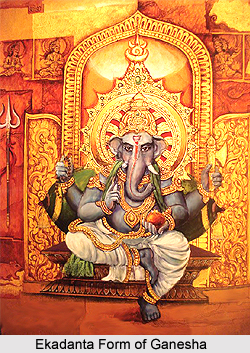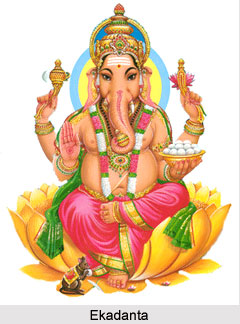 Ekadanta or Ekadanta Ganapati is one of the forms of Lord Ganesha mentioned in the Mudgala Purana which an Upapurana exclusively devoted to the Lord. The Ekadanta form denotes that the Lord Ganesha has a Single Tusk. The elephant-headed Hindu god is an embodiment of the essential nature of Brahman. It indicates the aggregate of all individual souls. Ekadanta is also considered as the 22nd form of the deity amongst the 32 forms of Lord Ganesha. The divine mouse Krauncha serves as his vahana in this avatar. The Lord was incarnated to eradicate Madasura, the demon of conceit and arrogance.
Ekadanta or Ekadanta Ganapati is one of the forms of Lord Ganesha mentioned in the Mudgala Purana which an Upapurana exclusively devoted to the Lord. The Ekadanta form denotes that the Lord Ganesha has a Single Tusk. The elephant-headed Hindu god is an embodiment of the essential nature of Brahman. It indicates the aggregate of all individual souls. Ekadanta is also considered as the 22nd form of the deity amongst the 32 forms of Lord Ganesha. The divine mouse Krauncha serves as his vahana in this avatar. The Lord was incarnated to eradicate Madasura, the demon of conceit and arrogance.
Legends of Ekadanta
The legend related to the Ekadanta Ganapati form is mentioned in the Padma Purana. One day Lord Parashurama went to visit Lord Shiva in Mount Kailash. But Ganesha prevented him from entering the abode. Hence Parashurama became enraged and threw his divine axe at Lord Ganesha. The elephant-faced deity knew that the sacred weapon was granted by his father Shiva; therefore He refused to block the divine axe and allowed it to chop one of his tusks. Thus Lord Ganesha was named Ekadanta. Later Parashurama bowed down before Lord Shiva, Goddess Parvati and Lord Ganesha and asked for forgiveness.
Another legend in the Ganesha Purana mentions that Ganesha once cursed the moon (Lord Chandra). Once Lord Ganesha had a consumed several modakas (sweet balls) and laddoos. But while he was departing on his mount, the divine mouse Krauncha, a snake appeared in front of them. The mouse became scared and tripped. Consequently, Ganesha fell down on his back and His stomach burst open due to the impact. All the sweets came out of His stomach, but Ganesha gathered all the sweets and put it back in His belly. Then He tied the snake around his waist to hold it together. The moon (Chandra) started laughing after seeing this incident.
 Lord Ganesha became agitated and in anger he broke one of his own tusks and threw it at the moon. The Lord also cursed the moon that would not be able to shine in his full glory. Later all the gods and the moon prayed to the elephant-headed god. Lord Chandra asked for Ganesha`s forgiveness. This pleased the Lord and he removed the curse. After this incident Lord Ganesha was named Ekadanta Ganapati. Another legend mentions that Ganesha used His broken tusk to script the epic Mahabharata. He acted as a scribe to Sage Ved Vyas.
Lord Ganesha became agitated and in anger he broke one of his own tusks and threw it at the moon. The Lord also cursed the moon that would not be able to shine in his full glory. Later all the gods and the moon prayed to the elephant-headed god. Lord Chandra asked for Ganesha`s forgiveness. This pleased the Lord and he removed the curse. After this incident Lord Ganesha was named Ekadanta Ganapati. Another legend mentions that Ganesha used His broken tusk to script the epic Mahabharata. He acted as a scribe to Sage Ved Vyas.
Appearance of Ekadanta
Ekadanta Ganapati is portrayed with a single tusk. In this incarnation, Lord Ganesha has a large stomach, four arms and blue complexion. The pot-belly of the deity is much larger in this form and it indicates the materialization of the universe within the Lord. He carries His own broken tusk in His main right hand and holds a sweet ball in the main left hand. Ekadanta holds Rudraksha beads in the upper right hand and a battle axe in His upper left hand.
The devotees of Ganesha worship the Ekadanta form to achieve success and improve their power of concentration. The single tusk of the deity signifies that He will sacrifice anything to fulfill the wishes of His worshippers. There are several temples in the country that are devoted to this form of Ganesha. An idol of Ekadanta Ganapati is also worshipped at the Ajanta and Ellora Caves in the state of Maharashtra.
Ekadanta Ganapati Mantra
The Lord is worshipped by the recitation of the Ekadanta Ganapati Mantra. It is mentioned as follows-
Lambodaram Shyamatanum Ganesham
Kutaramakshastraja Moordhavagaatram
Saladukkam Dantamadhaha Karabhyam
Vameteraabhyam Cha Dadhaanameede









